Construction Materials And Technology: UNIT IV: Construction Equipments
Dewatering/Pumping Equipments in Construction
Dewatering equipment are used to perform dewatering on construction sites, which is defined as the process of separating water from another material like saturated soil or sludge.
DEWATERING/PUMPING EQUIPMENTS
Dewatering equipment are used to perform
dewatering on construction sites, which is defined as the process of separating
water from another material like saturated soil or sludge. The separation of
water is performed by using a force generated by vacuum or centrifugal motion.
Dewatering equipment saves money by reducing solids handling and disposal
expenses. It is an alternative and economical option compared with heat drying
systems for water removal. The selection of dewatering equipment depends on the
corrosion potential of the material removed and the contaminants present in the
liquid. As the reactivity of the liquid increases, the equipment is constructed
with more durable materials. The most common methods used for dewatering are
discussed as follows:
Dewatering methods
* Sump
pumping: In this method of dewatering water is disposed by adjusting the
pump of the trench. Centrifugal pumps are generally more useful. This method is
used for shallow bases in waterlogged areas. In this way ditches are dug on
both sides of the trench. The ditches size is usually 20 cm in diameter of a
semicircle. Sumps are made at a distance of 40 m to 60 m in the ditches. The
size of the Sumps is kept as 1m x 1m xlm. The water flows into the ditches and
collects in the Sumps. Water is pumped out from the Sumps continuously.
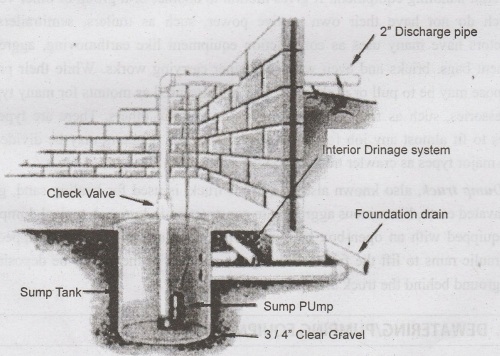
* Deep
well construction: This method of dewatering is more suitable
when digging operation (digging trench) is lower than water table or artesian
water present in soil. This method is useful when the groundwater level needs
to be lowered further. Wells are large-diameter (greater than 6 inches) holes,
drilled relatively deep (greater than 10 feet), and contain slotted casings and
down hole pumps. Wells work best in soils consisting of sand, or sand and
gravel mixtures and can dewater large areas to great depths.
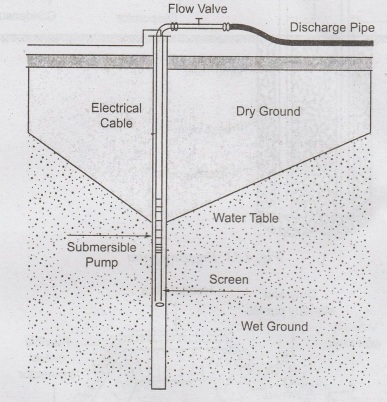
* Freezing
methods of dewatering: In this method, large pipes of 10 to 15 cm
diameter are laid in the ground around the area where excavation is to be done.
The spacing between such pipes is 1 to 1.5 m. These pipes are closed at the
lower end. Small pipes of 5 cm diameter are laid, which are open or perforated
at the lower end. The upper ends of all small pipes are connected to the
refrigeration plant by a single pipe. In these small pipes, 23°C to 30°C cold
water or other liquid is circulated. Coldwater escapes from a small pipe and
climbs up into a large pipe and returns to the refrigeration plant. This cold
water freezes the moist soil and forms a wall of frozen clay.
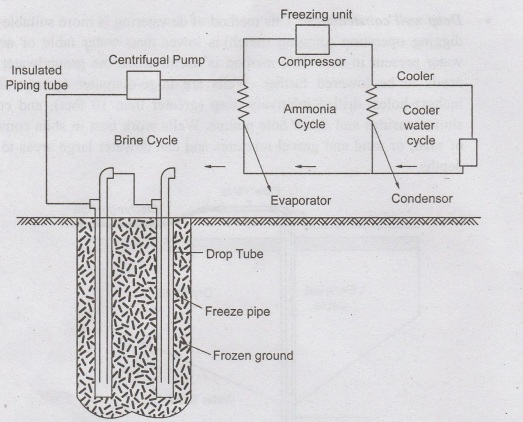
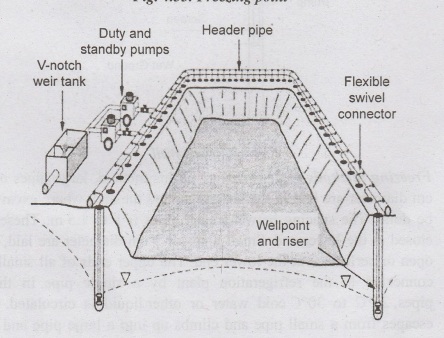
* Well
points: In this method of dewatering the ground water flow is te
diverted into deep well-points in the ground and the part to be excavated is
kept free from ground water. Well points are prepared at a distance of about 1m
around the area to be excavated. Water is released at the rate of 20 to 25
liters per second at these well points, which causes the soil to be dug and the
well point to sink deeper into the ground. The water edge is maintained for a
short time even after the well point has reached the prescribed depth. This
creates annular space around the well point as the rises. The water flow is
then stopped and filtered material like sand and gravel is filled in the
annular space around the well point which stops the filling of soil particles
as well as debris at the well point. Well - points are attached to the header
with riser, tee-piece, and Swinger arm. The header pipe is paired with a
suction pump to create a vacuum in the well-point and riser, so that water from
the surrounding land enters the header through the well-point and descends to
the ground water table. Well point systems may be single stage or multiple
stage:
Single
stage system: Water can be lifted from a depth of 5 m with
a suction pump. Therefore this method is used where the depth of excavation
does not exceed 5 m. The plant is not disturbed until the excavation work is
completely completed.
Multiple
stage system: When excavation depth is more than 5 m below
ground level (W.T.), well-point system is done in phases. In the first stage
excavation is carried out to a depth of 5m by arranging the required
well-points. In the second stage additional well points are dug into the ground
and excavated to a further depth of 5m. This is a way, how well-points are
arranged and excavated to a greater depth. The sides of the excavation are
given a proper slope.
* Cement
grouting: Cement grout is a mixture of cement, sand and, water. In
this process several holes are made in the ground. Cement grout is forcibly
inserted into each of these holes. The grout is filled in the hall until the
grout comes out of the hall. Cement grout freezes in stone cracks and clay
cavities, making the stone or clay water-tight and monolithic. Minimal channels
of resistance are prepared before starting grouting in soft soil. For this at a
short distance two bottom perforated pipes are pushed into the soil and water
is forcibly inserted in one of them and water is forcibly inserted in the first
pipe till water appears in the other pipe. In this way, minimum barrier channel
is formed between the two pipes. In this way many other minimal barrier
channels are formed in the soil. Then the cement slurry is forcibly inserted in
the pipe through which the water has inserted. It is inserted by force and the
cement slurry is continued to be inserted until cement slurry appears in the
second, perforated pipe. Hence a waterproof layer is formed by forcibly inserting
grout into the soil around the channel. And that way the springs of water in
the base trenches can be stopped. He or
* Chemical
consolidation of soils: In this method of dewatering, the
soil around the area to be excavated is hardened with a solution of chemical
compounds like silicate of soda and calcium chloride. In this method also pipes
are lowered into the ground. When a pipe is lowered into the ground, a chemical
is forced into it. The first chemical insertion is done after the pipe reaches
the appropriate depth. The pipe is then slowly pulled out and at the same time
another chemical is forcibly inserted into the pipe. The chemical reaction
between these two chemicals makes the soil hard. This method is very costly.
Dewatering equipments
The type of dewatering equipment to be used
will depend on the corrosion potential of the material, such as sludge, to be
pumped, hazardous contaminants, and so on. Equipment may need to be constructed
with durable materials. There are a number of different types of dewatering
equipment:
* Centrifuges
separate
solids from liquids through sedimentation and centrifugal force. A bowl,
spinning at high speed, separates the water from the solids which are compacted
against the bowl walls. Centrifuges remove solids from liquids through the
process of sedimentation and centrifugal force. The solids sludge is fed
through the stationary feed tube. The sludge moves with acceleration through
the ports in the conveyor shaft, which is then distributed to the periphery of
the bowl.
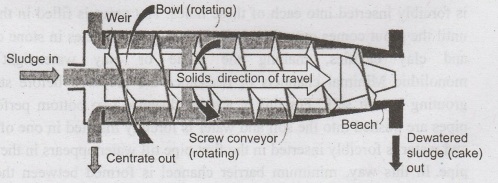
* Vacuum
filters involve creating a vacuum to draw out water from solids.
They can dry solids enough to eliminate the need for subsequent steps such as
digestion or heat treatment before disposal, incineration, or usage. A vacuum
filter is an equipment that creates a vacuum to draw water from the solids. The
filter consists of a drum submerged on a cake or sludge. A filtering medium is
placed over the drum. The whole arrangement of valves and pipes is such that
vacuum is applied to the inner side of the filter medium when the drum rotates.
The rotation of the drum draws water from the sludge. When the drum carries the
sludge to the atmosphere, the cake layer formed is chipped by a knife blade.
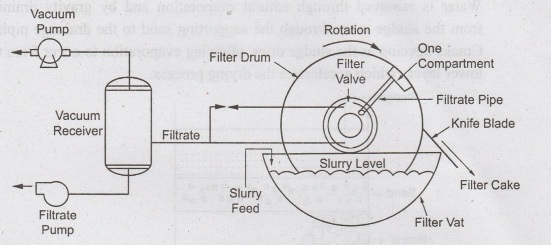
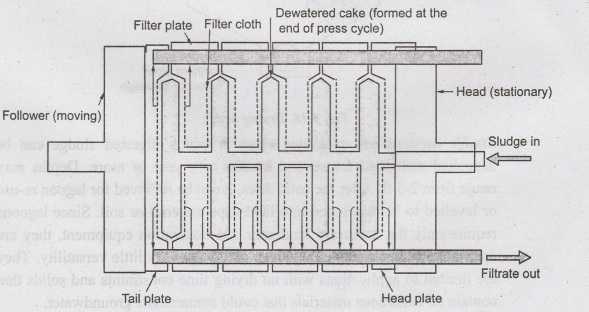
* Filter
presses use a porous press to separate solids from liquids.
Solids are captured in pores between two or more porous plates, and built up on
the surface. Water is forced through the pores either from plate pressure by
pushing the plates together or from a build-up of solids pressure by
continuously pushing solids into the cavities. This equipment uses a filter
medium to separate solids from the liquids. A filter press captures the solids
in the pores between two or more porous plates. bom
* Drying
beds
consist of perforated or open joint drainage pipes laid within a gravel base.
Sludge is placed on top of a sand layer and allowed to dry. Water is removed
through natural evaporation and by gravity draining from the sludge mass
through the supporting sand to the drainage piping. Cracks develop as the
sludge dries, allowing evaporation to occur from the lower layers which
accelerates the drying process.
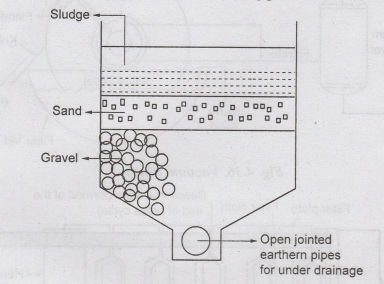
* Sludge
lagoons are excavated areas in which digested sludge can be
deposited and dried for several months to a year or more. Depths may range from
2-6 ft. After the solid dries, it can be removed for lagoon re-use or levelled
to be developed into landscape material or soil. Since lagoons require only the
necessary land area and excavation equipment, they are operationally
inexpensive; however, they have very little versatility. They are limited to
applications with no drying time constraints and solids that contain no
hazardous materials that could contaminate groundwater.
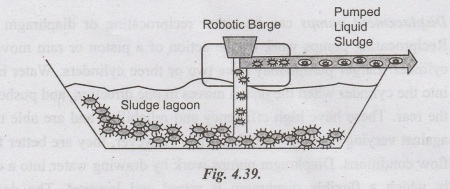
Pumps simply remove liquid from a volume of
liquid, whereas dewatering equipment separates water from another material such
as soil or sludge. They can be used for a number of different operations,
including:
❖ To keep water out of foundations, pits,
tunnels, and other excavations.
❖To lower the water table below excavation
level.
❖To pump water out of cofferdams.
❖To
supply water for jetting, sluicing and other general purposes.
❖To
drying solids and foundation grouting.
The choice of pumping equipment depends on
various factors, such as:
❖ The type of liquid to be pumped
❖ The amount of liquid to be moved
❖ The
rate at which the liquid needs to be moved
❖ The height of the suction lift - distance
from the water to the pump
The different types of pump used for dewatering are
discussed below:
* Centrifugal
pumps contain a rotating impeller which creates a vortex that sucks air out
of the hose. Water rises to the pump as a result of atmospheric pressure.
Priming involves filling the pump casing with liquid before the pump is
started. This is done to prevent the casing becoming filled with vapours or
gases that inhibit pumping. Self-priming pumps have a reserve supply of water
in the impeller chamber. Air-operated centrifugal pumps, often known as 'sump
pumps', consist of a small centrifugal pump fixed to an air motor. These are
often used in tunnels and foundation pits to handle sewage, oil or sludge
* Displacement
pumps can be either reciprocating or diaphragm pumps.
Reciprocating pumps work by the action of a piston or ram moving in a cylinder.
Larger pumps may have two or three cylinders. Water is drawn into the cylinder
when the piston moves in one direction, and pushed out at the rear. These have
high efficiency and reliability, and are able to pump against varying heads at
a uniform rate. However, they are better for low- flow conditions. Diaphragm
pumps work by drawing water into a cylinder in which a flexible diaphragm is
raised and lowered. The downward motion of the diaphragm pushes the water out
through the delivery pipe. They can pump liquids containing 10-15% solids, and
are suitable for work where the flow of water varies greatly.
*
Submersible pumps
can be used for lowering groundwater or removing water from a deep sump. The
pump unit is suspended from the rising main or, if a flexible hose is used,
from a wire cable. The pump consists of a centrifugal unit and motor mounted in
a single cylindrical unit with a space between pump and casing which allows the
water to move upwards to the rising main. They are intended for heavy duty work
that involves lifting gritty water.
* Air
lift pumps consist, not of moving parts, but of a long vertical
pipe connected to a supply of compressed air. The air carries the water up the
pipe to the discharge area. Air lift pumps are often used for moving silt from
the base of a cofferdam.
Construction Materials And Technology: UNIT IV: Construction Equipments : Tag: : - Dewatering/Pumping Equipments in Construction
Related Topics
Related Subjects
Construction Materials and Technology
CE3302 3rd Semester Civil Dept 2021 Regulation | 3rd Semester Civil Dept 2021 Regulation
